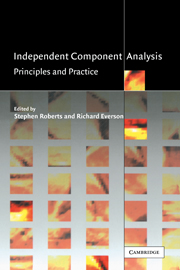Book contents
- Frontmatter
- Contents
- Preface
- Contributors
- 1 Introduction
- 2 Fast ICA by a fixed-point algorithm that maximizes non-Gaussianity
- 3 ICA, graphical models and variational methods
- 4 Nonlinear ICA
- 5 Separation of non-stationary natural signals
- 6 Separation of non-stationary sources: algorithms and performance
- 7 Blind source separation by sparse decomposition in a signal dictionary
- 8 Ensemble Learning for blind source separation
- 9 Image processing methods using ICA mixture models
- 10 Latent class and trait models for data classification and visualisation
- 11 Particle filters for non-stationary ICA
- 12 ICA: model order selection and dynamic source models
- References
- Index
10 - Latent class and trait models for data classification and visualisation
Published online by Cambridge University Press: 05 July 2014
- Frontmatter
- Contents
- Preface
- Contributors
- 1 Introduction
- 2 Fast ICA by a fixed-point algorithm that maximizes non-Gaussianity
- 3 ICA, graphical models and variational methods
- 4 Nonlinear ICA
- 5 Separation of non-stationary natural signals
- 6 Separation of non-stationary sources: algorithms and performance
- 7 Blind source separation by sparse decomposition in a signal dictionary
- 8 Ensemble Learning for blind source separation
- 9 Image processing methods using ICA mixture models
- 10 Latent class and trait models for data classification and visualisation
- 11 Particle filters for non-stationary ICA
- 12 ICA: model order selection and dynamic source models
- References
- Index
Summary
Introduction
Independent Component Analysis (ICA), as a signal processing tool, has shown great promise in many application domains, two of the most successful being telecommunications and biomedical engineering. With the growing awareness of ICA many other less obvious applications of the transform are starting to appear, for example financial time series prediction [Back & Weigend, 19981 and information retrieval [Isbell & Viola, 1999, Girolami, 2000a, Vinokourov & Girolami, 20001. In such applications ICA is being used as an unsupervised means of exploring and, hopefully, uncovering meaningful latent traits or structure within the data. In the case of financial time series prediction the factors which drive the evolution of the time series are hopefully uncovered, whereas within information retrieval the latent concepts or topics which generate key-words that occur in the documents are sought after. The strong assumption of independence of the hidden factors in ICA is difficult to argue for when there is limited a priori knowledge of the data, indeed it is desired that the analysis uncover injormative components which may, or may not, be independent. Nevertheless the independence assumption allows analytically tractable statistical models to be developed.
This chapter will consider how the standard ICA model can be extended and used in the unsupervised classification and visualisation of multivariate data. Prior to the formal presentation, to set the context of the remainder of the chapter, a short review of the ICA signal model and the corresponding statistical representation is given. The remaining sections propose ICA inspired techniques for the unsupervised classification and visualisation of multivariate data.
- Type
- Chapter
- Information
- Independent Component AnalysisPrinciples and Practice, pp. 254 - 279Publisher: Cambridge University PressPrint publication year: 2001
- 2
- Cited by



